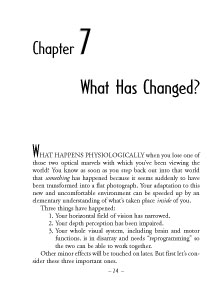 |
| The first step to compensating for eye loss is to determine what exactly has changed and how that change affects perception. Here, Mr. Brady provides an accurate and understandable description of the visual system from the unique perspective of a scientist and a person who has experienced changes to this system firsthand. "Three things have happened: • Your horizontal field of vision has narrowed • Your depth perception has been impaired. • Your whole visual system, including brain and motor functions, is in disarray and needs reprogramming so the two can be able to work together in an integrated fashion." (pg. 25) Many of these losses can be compensated for with increased attention; and they soon become merely "a nuisance." "Actually, there's more nuisance than danger, once you've made adjustments to your new limitation. If the loss of lateral vision seems enormous to you (10 to 20 %)--as it usually does at first--keep in mind that it's really less than many persons with two good eyes inflict on themselves voluntarily by wearing heavy rimmed glasses." (p. 27) Chapter 1. An Unhappy Landing Chapter 2. An Awkward Takeoff Chapter 3. Jolts of Reality Chapter 4. Flying High Chapter 5. How About You? Chapter 6. Seeing in 3-D—How It Works Chapter 7. What Has Changed? Chapter 8. Getting Back to 3-D Chapter 9. Avoiding Problems and Possible Mistakes Chapter 10. In the Driver’s Seat Chapter 11. The Active Life Chapter 12. Let Technology Help Chapter 13. Keeping the Good Eye Good Chapter 14. Seeing to Your Looks Chapter 15. Eye-making (Ocularistry) Chapter 16. Driving and Piloting Licenses Chapter 17. For Parents Only Chapter 18. Senior Class Chapter 19. In Good Company Glossary Resources |